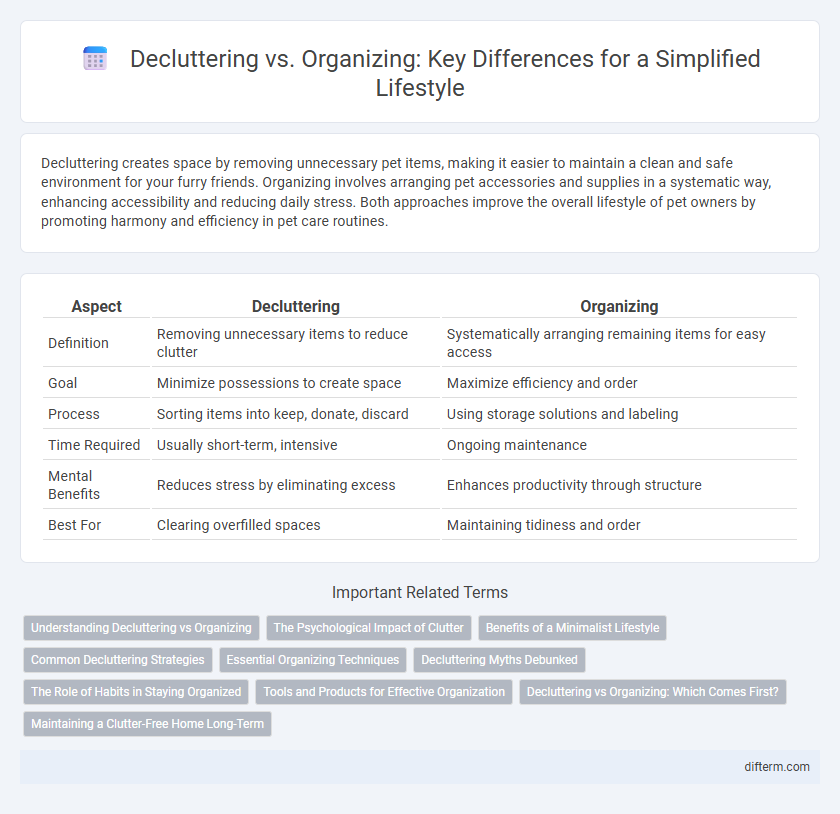Decluttering creates space by removing unnecessary pet items, making it easier to maintain a clean and safe environment for your furry friends. Organizing involves arranging pet accessories and supplies in a systematic way, enhancing accessibility and reducing daily stress. Both approaches improve the overall lifestyle of pet owners by promoting harmony and efficiency in pet care routines.
Table of Comparison
| Aspect | Decluttering | Organizing |
|---|---|---|
| Definition | Removing unnecessary items to reduce clutter | Systematically arranging remaining items for easy access |
| Goal | Minimize possessions to create space | Maximize efficiency and order |
| Process | Sorting items into keep, donate, discard | Using storage solutions and labeling |
| Time Required | Usually short-term, intensive | Ongoing maintenance |
| Mental Benefits | Reduces stress by eliminating excess | Enhances productivity through structure |
| Best For | Clearing overfilled spaces | Maintaining tidiness and order |
Understanding Decluttering vs Organizing
Decluttering involves removing unnecessary items to create a cleaner, simpler environment, while organizing focuses on arranging and categorizing belongings for easier access and functionality. Understanding decluttering versus organizing helps prioritize tasks by first eliminating excess before systematizing what remains. Effective lifestyle management combines both strategies to enhance living spaces and reduce stress.
The Psychological Impact of Clutter
Clutter creates a constant visual distraction that overwhelms the brain, leading to increased stress levels and reduced productivity. Psychological studies link cluttered environments to feelings of anxiety and decreased ability to focus, impacting mental well-being. Organizing, rather than merely decluttering, helps establish order and control, promoting calmness and enhancing cognitive function.
Benefits of a Minimalist Lifestyle
Embracing a minimalist lifestyle through decluttering enhances mental clarity and reduces stress by eliminating unnecessary possessions that cause distraction. Organizing retained items maximizes space efficiency and simplifies daily routines, promoting productivity and calmness. This lifestyle fosters intentional living, allowing individuals to focus on meaningful experiences rather than material accumulation.
Common Decluttering Strategies
Common decluttering strategies include the KonMari Method, which emphasizes keeping items that spark joy, and the Four-Box Technique, where belongings are sorted into keep, donate, trash, or relocate categories. Time-blocking sessions specifically for decluttering can prevent overwhelm and maintain consistency. Prioritizing high-traffic areas like entryways and kitchens maximizes visible impact and motivates ongoing organization efforts.
Essential Organizing Techniques
Essential organizing techniques prioritize categorizing items by function and frequency of use to enhance accessibility and efficiency. Utilizing storage solutions such as labeled bins, drawer dividers, and vertical shelving maximizes space and maintains order. Regularly reassessing possessions and implementing habit-forming routines ensure long-term maintenance of an organized living environment.
Decluttering Myths Debunked
Decluttering is often misunderstood as simply throwing things away, but it actually involves thoughtfully assessing the necessity and value of each item to create a functional space. Common myths, such as decluttering being a one-time event or requiring drastic minimalism, ignore the ongoing, personalized nature of maintaining a clutter-free environment. Effective decluttering prioritizes intentional living and psychological well-being, not just physical tidiness.
The Role of Habits in Staying Organized
Habits play a crucial role in maintaining an organized lifestyle by reinforcing consistent actions like regular tidying and designated storage use, which prevent clutter buildup. Establishing routines such as daily sorting and mindful disposal significantly reduces stress associated with disorder and enhances productivity. Effective habit formation integrates small, manageable tasks that collectively support long-term organization and a clutter-free living environment.
Tools and Products for Effective Organization
Selecting the right tools and products is crucial for effective organization, with options like modular storage bins, label makers, and drawer dividers enhancing space utilization. Decluttering benefits from donation boxes, recycling bags, and trash bins, which streamline the removal of unnecessary items. Combining these resources promotes a balanced approach, transforming cluttered areas into functional, aesthetically pleasing living spaces.
Decluttering vs Organizing: Which Comes First?
Decluttering comes first in the process because it eliminates unnecessary items, creating a clear space for effective organizing. Prioritizing decluttering reduces clutter and helps identify what truly needs to be stored or arranged. Organizing afterward maximizes efficiency, ensuring that items have designated places within a streamlined and functional environment.
Maintaining a Clutter-Free Home Long-Term
Maintaining a clutter-free home long-term requires consistent organizing habits rather than one-time decluttering sessions. Implementing designated storage solutions and regularly assessing items for necessity prevents accumulation and supports sustainable tidiness. Prioritizing daily habits like putting things back immediately and mindful purchasing dramatically reduces clutter over time.
Decluttering vs Organizing Infographic

 difterm.com
difterm.com